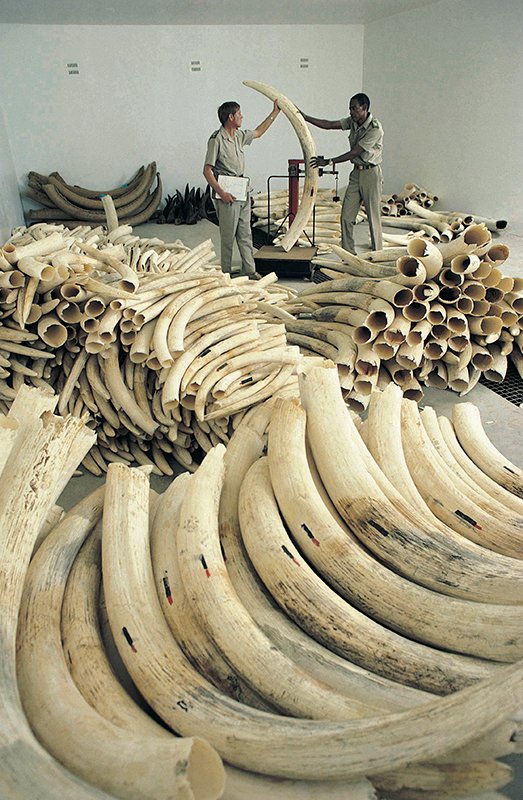
The Ivory Trade: A Business Built on Blood and Bones
The poachers come at night on the Tanzanian savannah. With their automatic rifles and night vision goggles, they look more like soldiers than hunters. They’ve spotted their target: a bull African bush elephant, whose 10-foot (3 m) tusks nearly scrape the ground, each weighing over 150 pounds (68 kg). As the giant rumbles toward a watering hole, the poachers pull their triggers. The elephant trumpets in pain, whirling in confusion and attempting to escape his attackers. When he crashes to the ground, the real work begins. Using chainsaws and machetes, the poachers hack at the elephant’s face, carving his tusks from his skull. After this successful night, their pay will be substantial, and their bosses will be pleased. As morning dawns, the leftover carcass rots in the sun.
This gruesome scenario occurs about every 15 minutes in Africa, as poachers slaughter tens of thousands of elephants every year to illegally supply ivory to the international multibillion-dollar black-market industry. In the last century, the number of African elephants has decreased from an estimated 12 million to just 400,000. In Asia, only roughly 40,000 elephants remain. The decreased population is having devastating consequences to ecosystems where elephants act as keystone species.
When God created the world 6,000 years ago, there was no death, pain, or suffering (Genesis 1:29–31). God created Adam and Eve in his image and gave them dominion over the earth (Genesis 1:26–27). Unfortunately, their sin brought the curse into creation, and we now live in a broken world where humans often fail to obey God’s command to righteously steward the animals he created (Genesis 1:28, 3:1–19, 9:9–11; Exodus 23:4–5; Psalm 36:6). But elephants aren’t the only casualties in this heinous industry. The abuse stemming from the lust for ivory extends to humans involved in the trade.
Teeth or Treasure
Elephant tusks are the animal’s upper incisor teeth. Extending from sockets inside each elephant’s skull, one-third of each tusk is hidden in the cranial cavity. The exposed portions are used for digging, fighting, gathering food, lifting, protecting the sensitive trunk, and scraping bark from trees.
But unlike typical mammalian teeth, elephant tusks—as well as certain teeth of elk, hippos, orcas, sperm whales, walruses, and warthogs—contain mineralized collagen. This feature gives ivory its beauty, durability, and malleability that have made these specialized teeth treasured throughout history. People have carved ivory into chess sets, figurines, jewelry, piano keys, statues, and more. However, the true allure of ivory comes from the status of wealth it symbolizes.
Ivory artifacts and records of elephant hunting remain from early people groups like the ancient Egyptians, Greeks, and Romans. Scripture tells us that King Solomon had a great ivory throne overlaid with gold (1 Kings 10:18). Today, especially in eastern countries, an ivory bangle or statue speaks of fortune. Within mystic religions, ivory is considered a good luck charm and is ground up for use in traditional medicines. Two pounds (1 kg) of ivory costs up to $3,000 on the black market. In fact, ivory is sometimes called white gold.
A Dark History
Ivory poaching really took off in the 1600s as European nations began colonizing the world. By the 1700s and 1800s, elephant populations began disappearing. In 1822, South Africa became the first nation to regulate elephant hunting. However, by the early 1900s, up to 1,000 tons (907,185 kg) of ivory were still being exported from Africa annually. Between 1970 and 1990, poachers slaughtered 700,000 African elephants—half of the remaining population.
In 1989, a worldwide ban on the sale of ivory took effect when African elephants were listed in the highest protection level of CITES (Convention on International Trade in Endangered Species), joining Asian elephants which had been listed in 1975. This ban initially curbed much of the killing, but new black-market opportunities soon opened from crime syndicates who relied on ivory to fund their operations.
In 2008, China won a one-time sale of 62 tons (56,245.5 kg) of ivory from CITES, causing the death of a staggering 100,000 elephants from 2010 to 2012 alone. Then a near-total ban on the sale and trade of ivory in the US in 2016 and China in 2018, the world’s two biggest consumers of ivory, finally helped decrease poaching rates. Unfortunately, the black-market ivory trade continues, and widespread corruption among government officials and law enforcement makes completely halting the ivory trade a challenge.
The Human Element
It’s easy to think of poachers as greedy criminals carrying out heartless atrocities. But the situation is often more complex. The hunters themselves are not keeping the ivory or gaining most of the profits. Generally, the people getting their hands bloody are merely commissioned to garner the ivory to be sold. Poachers are often recruited from impoverished communities living off the harsh and dangerous land of the African savannah or Asian rainforests. These people risk being arrested or killed, sometimes by the elephants they’re hunting. But when the money they earn can relieve the effects of poverty on their families, the risk seems worth it. Due to an intricate system of players in the illegal ivory trade, even when poachers are apprehended, the actual masterminds behind the poaching network are rarely prosecuted, leaving their pawns to take the punishment.
On the other side of the struggle, rangers charged with protecting wildlife also face threats. In a 2019 survey of 2,061 rangers from Africa, 79% considered their job to be hazardous due to wildlife encounters, while 83% considered their job to be hazardous due to poacher encounters. According to the Thin Green Line Foundation (a group dedicated to protecting wildlife rangers), 50–70% of ranger deaths on the job are caused by conflicts with poachers. Rangers regularly experience PTSD from the stress of potentially lethal conflicts that require them to choose between killing poachers or saving the animals they love.
Sadly, the threat to wildlife rangers extends outside of national parks. In July of 2022, South African head park ranger Anton Mzimba was shot outside his home. Intelligence suggested that the ranger’s murder was in retaliation for his refusal to give the local poaching syndicate the location of a rhinoceros.

Above, park rangers weigh confiscated elephant ivory. Each year, an estimated 1.1 million pounds of poached ivory is shipped from Africa.
Seeking Solutions
There is no easy answer to poaching, but scientists and activists are trying to find one. Some are looking to mimicry for solutions. A few South American Phytelephas palms produce seeds, called Tagua nuts or vegetable ivory, that can be carved and shaped just like ivory. Scientists have also recently created a biodegradable synthetic that is chemically identical to ivory. However, some people argue that distributing these products runs the risk of creating more demand for the real thing, causing the value of authentic ivory to skyrocket.
Some are looking to the extinct relatives of elephants—the mammoths—as an alternative ivory source. Legally, ivory traders can harvest mammoth tusks that have naturally surfaced from melting permafrost (a subsurface layer of frozen soil). However, some miners skirt the law by blasting the ground with pressure hoses to unearth the tusks. Their forceful tactics can damage the surrounding environment by polluting rivers and making the earth unstable. Additionally, elephant ivory is being falsely sold as mammoth ivory to circumvent the ban.
A more effective method to curb the black-market ivory trade is by going after those at the top of the crime organizations. In Tanzania, an African elephant poaching hotspot, the government has recently arrested over 2,300 poachers and traffickers, including some high-level leaders in the illegal trade. And thanks to GPS trackers in planted ivory and genetic testing on seized ivory, authorities can now make connections between illegal shipments around the world, linking and prosecuting the responsible criminal syndicates.
But the most lasting solution to ending poaching is to halt the market at the consumer level. Wildlife organizations are looking to change consumer opinions toward ivory by dispersing messages discouraging its purchase and establishing the ivory market as socially unacceptable.
Truth in Darkness
Tragically, we’re charging toward a world without elephants. Though God gave us permission to hunt animals for their meat in our fallen world (Genesis 9:2–3), we are commanded not to destroy them (Deuteronomy 22:6–7). And unlike meat that serves as food, ivory is an indulgence unnecessary for human survival.
As stewards of God’s creatures (Genesis 1:28), Christians should work to protect these magnificent creatures from mankind’s sinful greed by refusing to purchase ivory products and by supporting conservation efforts to stop poaching and ivory trafficking. But we can also support mission work in areas where poaching is practiced and where ivory is still an irresistible mark of status. And we can pray the truth will find its way to those trapped in the darkness of the black-market trade, calling them to turn from abusing the creatures they believe can offer them fortune and instead worship the Creator who made these majestic animals and calls us to the honor of stewarding them well.
Answers Magazine
April–June 2023
Gap theorists insert millions of years between the first two verses of Genesis. But what really lurks in that gap?
Browse Issue SubscribeFootnotes
- World Wildlife Fund, https://www.worldwildlife.org/species/elephant
- “Life on the Frontline 2019: A global survey of the working conditions of rangers,” World Wildlife Fund, November 27, 2019, https://www.worldwildlife.org/publications/life-on-the-frontline-2019-a-global-survey-of-the-working-conditions-of-rangers.
- Jim Tan, “Wildlife Rangers Face a ‘Toxic Mix’ of Mental Strain and Lack of Support,” Mongabay, May 24, 2018, https://news.mongabay.com/2018/05/rangers-face-a-toxic-mix-of-mental-strain-and-lack-of-support/.
- Rachel Nuwer, “Killing of Ranger Protecting Rhinos Raises Fears for Conservation Efforts,” August 16, 2022, https://www.nytimes.com/2022/08/16/science/poaching-ranger-murder-rhino.html.
- Lucy Taylor, “Poaching Declines in Tanzania Following Prosecution of Ivory Trafficking Ringleaders,” Mongabay, June 17, 2021, https://news.mongabay.com/2021/06/poaching-declines-in-tanzania-following-prosecution-of-ivory-trafficking-ringleaders/.
- James Urton, “DNA Testing Exposes Tactics of International Criminal Networks,” UW News, February 14, 2022, https://www.washington.edu/news/2022/02/14/ivory-trafficking/.
Recommended Resources

Answers in Genesis is an apologetics ministry, dedicated to helping Christians defend their faith and proclaim the good news of Jesus Christ.
- Customer Service 800.778.3390
- © 2024 Answers in Genesis





